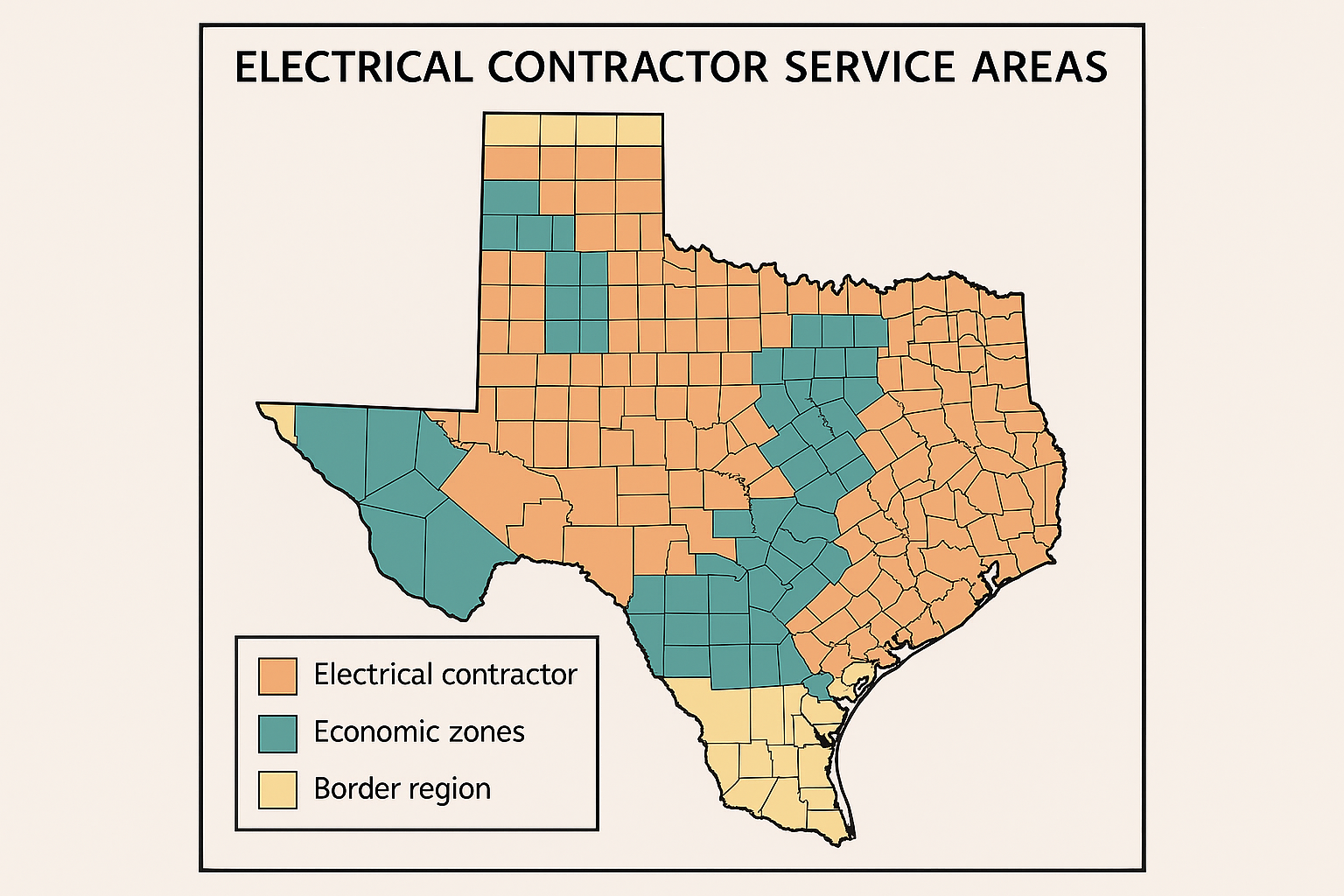Table of Contents
- Understanding Market Forces Beyond Your Hourly Rate
- The Geographic Money Game: Location-Based Salary Hacks
- Credential Stacking for Maximum Earning Power
- Business Model Evolution: From Employee to Entrepreneur
- Technology Integration as Your Salary Multiplier
- The Professional Presentation Advantage
- Final Thoughts
TL;DR
- Geographic arbitrage can boost your electrical contractor salary by 15-40% through strategic location choices and border town premiums
- Micro-specializations in smart buildings, renewable energy, and EV infrastructure can double or triple your earning potential
- The fractional contractor model allows you to earn 2-3x more while reducing physical labor demands
- Technology integration skills command premium rates of $150-$500 per hour for specialized consulting
- Credential stacking creates compound salary benefits rather than simple additions to your base rate
- Digital revenue streams from courses and consultations can generate $50,000-$200,000 annually in passive income
- Professional credential management protects your ability to command premium rates across multiple markets
The electrical contracting industry is experiencing unprecedented growth, with about 80,200 openings for electricians projected each year, on average, over the decade according to the Bureau of Labor Statistics. Most electrical contractors never discover the hidden economics that could multiply their earning potential beyond traditional hourly wages.
Understanding Market Forces Beyond Your Hourly Rate
I’ve watched too many skilled electricians get trapped thinking their electrical contractor salary depends solely on how many hours they work. This mindset keeps you stuck in a linear relationship between time and money while the contractors making serious money understand that market forces create opportunities that go way beyond trading hours for dollars.
Regional demand fluctuations happen constantly, but most contractors don’t pay attention to them. When a major manufacturing plant opens in your area, or when new housing developments get approved, these events create electrical contractor salary opportunities that can last for years. The smart contractors position themselves ahead of these trends instead of reacting after everyone else has caught up.
Why Traditional Salary Thinking Limits Your Potential
Every time electrical codes change or new safety regulations get implemented, there’s a window of opportunity for contractors who understand the implications. While most electricians see regulations as a hassle, I’ve learned to view them as profit opportunities.
New regulations create demand for specialized knowledge. When energy efficiency standards change, contractors who understand the new requirements can charge premium rates for compliance consulting. The key is staying ahead of these changes instead of reacting to them after everyone else has caught up.
Recent regulatory challenges in Alabama highlight the importance of understanding administrative compliance. “The Electrical Contractors Board paid the firm $510,000 for administrative services in FY2023” according to Alabama Daily News, demonstrating how regulatory complexity creates both challenges and opportunities for informed contractors who understand compliance requirements.
The Regulatory Change Goldmine
Have you ever noticed how some contractors seem to know about code changes months before they take effect? These contractors build relationships with code officials, attend industry meetings, and subscribe to regulatory updates. When changes happen, they’re already positioned as the experts who can help other contractors and building owners navigate the new requirements.
This positioning creates multiple revenue streams. You can offer training to other contractors, provide compliance consulting to building owners, and charge premium rates for work that requires knowledge of new regulations. The contractors earning the most from regulatory changes treat compliance as a business opportunity rather than a burden.
The Geographic Money Game: Location-Based Salary Hacks
Smart electrical contractors can leverage location-based salary differentials to maximize their earning potential through strategic relocation and understanding of cross-border opportunities. The geographic arbitrage opportunity exists because proximity to state lines, international borders, and economic zones creates dramatic pay variations within surprisingly small areas.
I’ve seen contractors increase their electrical contractor salary by 15-40% simply by understanding these geographic advantages and positioning themselves accordingly.
Cross-Border Salary Differentials That Actually Matter
Working near state borders creates unique opportunities that most contractors completely miss. The competitive bidding between jurisdictions with different labor regulations and tax structures drives up wages in these areas. I’ve seen electrical contractors working in border towns command 15-25% higher wages just because of their location.
The border town premium effect happens because companies on both sides of state lines compete for the same skilled contractors. If you’re willing to work projects in multiple states, you can leverage this competition to your advantage. Some contractors I know have built their entire business model around this geographic arbitrage.
Understanding the educational requirements for electrical work is crucial when considering cross-border opportunities, as different states may have varying certification standards. Our electrician education guide provides comprehensive information about meeting licensing requirements across multiple jurisdictions.
| Location Factor | Salary Impact | Key Considerations |
|---|---|---|
| State Border Proximity | 15-25% increase | Multi-state licensing requirements |
| Economic Development Zones | 30-40% increase | Tax incentive duration |
| Metropolitan Areas | Variable premium | Cost of living adjustments |
| Rural vs Urban Markets | 20-35% difference | Travel time and expenses |
Economic Development Zone Multipliers
Special economic zones and tax incentive areas inflate contractor salaries by 30-40% above regional averages. These zones exist to attract business investment, and part of that attraction includes higher wages for skilled trades. The problem is that most contractors don’t even know these zones exist in their area.
Finding these opportunities requires research, but the payoff is substantial. Economic development zones often have multi-year tax incentives, which means the higher wages aren’t temporary. You can build a sustainable business around serving these areas.
Remote Work Revolution Impact on Electrical Contracting
The shift toward remote project management has created new salary categories for electrical contractors who blend traditional fieldwork with digital expertise. Virtual project management premiums allow contractors who master remote oversight and digital collaboration tools to charge 20-35% more than traditional on-site-only professionals.
A journeyman electrician in Texas expanded his service area by 200 miles by mastering remote project management tools. He now oversees three simultaneous commercial projects using drone inspections, digital documentation, and video collaboration, earning $125/hour compared to his previous $85/hour rate for traditional on-site work.
Clients save money on travel and overhead expenses when contractors can manage projects remotely, and they’re willing to pay premiums for this efficiency. The contractors earning these premiums have invested in learning project management software, video collaboration tools, and digital documentation systems.
This isn’t about replacing fieldwork entirely – it’s about adding remote capabilities to your skill set. The contractors making the most money combine hands-on expertise with digital project management skills.
Credential Stacking for Maximum Earning Power
Beyond basic licensing, electrical contractors can dramatically increase their earning potential through strategic accumulation of specialized certifications that create compounding salary benefits. The credential stacking strategy involves identifying and dominating ultra-specific electrical niches that command premium rates due to limited qualified professionals.
I’ve discovered that combining multiple certifications creates exponential rather than additive electrical contractor salary benefits through improved market positioning and client perception.
Micro-Specialization Premium Markets
The real money in electrical contracting comes from becoming the go-to expert in very specific niches. While general electrical contractors compete on price, specialists compete on expertise. The difference in earning potential is dramatic.
Smart building integration specialists can earn 40-60% more than general electrical contractors because this rapidly growing field has a severe shortage of qualified professionals. The Internet of Things (IoT) revolution in commercial buildings creates constant demand for contractors who understand both electrical systems and digital integration.
The demand for specialized electrical work is reflected in current market rates, with certified electricians earning an average of $63,000 per year, compared to $59,000 for non-certified electricians according to BuildForce, demonstrating the immediate value of credential stacking.
Smart Building Integration Specialist Path
Becoming a smart building specialist requires understanding electrical systems, network infrastructure, and building automation software. It sounds complicated, but the learning curve isn’t as steep as you might think. The key is starting with one system and expanding your knowledge systematically.
The contractors earning the highest premiums in this field combine traditional electrical skills with IT knowledge. They can troubleshoot both power issues and network connectivity problems, making them invaluable to building owners.
Smart Building Certification Checklist:
- Complete BACnet protocol training
- Obtain KNX/EIB certification
- Learn Modbus communication systems
- Master wireless mesh networking
- Understand cybersecurity basics for IoT
- Practice with major building automation platforms
- Develop troubleshooting methodologies for integrated systems
Renewable Energy Transition Expert Opportunities
With the green energy boom, electrical contractors certified in solar, wind, and battery storage systems command premium rates. Some contractors report earning double the standard contractor salary in high-demand markets. The renewable energy transition isn’t a trend – it’s a fundamental shift that creates long-term opportunities.
Battery storage systems represent a particularly lucrative specialization because the technology is complex and safety requirements are strict. Contractors who understand energy storage can charge premium rates for both installation and maintenance work.
EV charging station installation and maintenance specialists are seeing unprecedented demand. Some contractors report 70-100% salary increases over traditional electrical work. The EV infrastructure buildout is just beginning, creating opportunities that will last for decades.
The technical requirements for EV charging infrastructure go beyond basic electrical work. Understanding power management, network connectivity, and payment processing systems makes contractors more valuable to clients who need comprehensive solutions.
The Certification Compound Effect
Combining multiple certifications creates exponential rather than additive salary benefits. Contractors holding certifications in both traditional electrical work and emerging technologies can position themselves as irreplaceable consultants rather than replaceable technicians.
Master electrician Sarah Chen combined her electrical license with smart building certifications and renewable energy credentials. She now charges $175/hour for integrated system consulting compared to $65/hour for traditional electrical work – a 169% increase that resulted from strategic credential stacking rather than years of experience.
The contractors earning the highest rates combine expertise across multiple domains. A contractor certified in both electrical systems and building automation becomes a systems integrator rather than just an electrician. This positioning change dramatically increases earning potential.
Clients pay premium rates for contractors who can handle complex projects without requiring multiple specialists. The ability to manage electrical, automation, and energy systems as integrated solutions makes you indispensable.
Business Model Evolution: From Employee to Entrepreneur
The electrical contracting industry is experiencing a fundamental shift from traditional employment models to hybrid business structures that can multiply earning potential for informed professionals. The fractional contractor model represents a revolutionary approach where electrical contractors provide part-time executive-level services to multiple companies, often earning more than full-time employees while maintaining flexibility.
I’ve observed that this business model evolution creates opportunities to transition from hands-on contractor to strategic electrical systems advisor, often resulting in 2-3x electrical contractor salary increases.
The Fractional Contractor Model Revolution
Traditional employment thinking limits your earning potential because you’re trading time for money in a linear relationship. The fractional contractor model breaks this limitation by allowing you to provide high-value services to multiple clients simultaneously.
Corporate electrical consultant positioning involves transitioning from hands-on contractor to strategic electrical systems advisor for businesses. This shift often results in 2-3x salary increases while reducing physical labor demands. The key is positioning yourself as a strategic resource rather than just a service provider.
When transitioning to higher-level consulting roles, maintaining professional credentials becomes crucial for client confidence. Our guide on business certification explains how to present your qualifications effectively in corporate consulting environments.
| Business Model | Monthly Revenue Potential | Time Investment | Scalability |
|---|---|---|---|
| Traditional Employee | $5,000-$8,000 | 160+ hours | Limited |
| Fractional Contractor | $12,000-$25,000 | 80-120 hours | High |
| Consulting + Retainers | $15,000-$40,000 | 60-100 hours | Very High |
| Platform + Courses | $20,000-$60,000 | 40-80 hours | Extremely High |
Establishing ongoing monthly consulting relationships with multiple clients creates predictable income that often exceeds traditional project-based billing by 150-200%. Retainer relationships provide income stability while allowing you to plan your time more effectively.
The contractors earning the highest retainer fees provide ongoing value through system monitoring, compliance consulting, and strategic planning. They become trusted advisors rather than just service providers.
Emergency Response Premium Services
Contractors who offer guaranteed 24/7 emergency response services can charge premium rates (often 3-5x standard rates) while building long-term client relationships. Emergency response premiums work because downtime costs businesses far more than premium service rates.
Building an emergency response business requires systems and processes, but the profit margins justify the investment. Clients pay premium rates for the peace of mind that comes with guaranteed response times.
The Platform Economy Leverage
Using digital platforms and technology to scale expertise beyond physical presence creates multiple income streams from a single skill set. The platform economy allows contractors to monetize their knowledge in ways that weren’t possible before.
Experienced electrical contractors can generate substantial passive income by creating and selling online training courses. Some contractors earn $50,000-$200,000 annually from course sales alone. The key is creating courses that solve specific problems for other contractors or building owners.
Course creation requires upfront investment in time and possibly equipment, but successful courses generate income for years. The contractors earning the most from courses focus on practical, actionable content rather than theoretical knowledge.
Platforms allow electrical contractors to monetize their expertise through hourly consultations, often earning $200-$500 per hour for specialized advice. These platforms connect you with clients who need specific expertise for short-term projects or problem-solving.
The contractors earning the highest consultation rates have built reputations in specific niches. General electrical advice doesn’t command premium rates, but specialized knowledge in areas such as energy management or code compliance does.
The Equity Participation Strategy
Moving beyond traditional salary structures to participate in business ownership and profit-sharing arrangements can multiply long-term wealth accumulation. Equity participation transforms you from an employee to a business partner.
Negotiating equity stakes or profit-sharing arrangements with electrical contracting companies transforms your relationship from employee to business partner. Performance-based equity acquisition structures compensation packages that include equity earning potential based on performance metrics, often resulting in long-term wealth that exceeds traditional salary expectations by 5-10x.
Partnering with other professionals or companies creates new revenue streams that leverage electrical expertise in innovative ways. Real estate development partnerships allow electrical contractors to earn both project fees and ongoing revenue from property ownership, creating multiple income streams from single projects.
Electrical contractor Mike Rodriguez partnered with a real estate developer to provide electrical consulting for a 50-unit apartment complex. Instead of accepting a $75,000 project fee, he negotiated 3% equity ownership. The development generated $2.3 million in profits, earning Rodriguez $69,000 in equity returns plus ongoing property management electrical work worth $15,000 annually.
Technology Integration as Your Salary Multiplier
The convergence of electrical systems with advanced technology creates unprecedented earning opportunities for contractors who position themselves at the intersection of traditional electrical work and cutting-edge innovation. Data-driven contractors who leverage analytics and performance metrics to optimize their services can command significantly higher rates than those operating on traditional approaches.
I’ve found that predictive maintenance revenue models and digital twin implementation consulting represent the highest-paying opportunities in this technology integration space, often exceeding the average electrical contractor salary by 200-400%.
The Data-Driven Contractor Advantage
Electrical contractors who leverage data analytics and performance metrics to optimize their services and client outcomes can command significantly higher rates than those operating on traditional intuition-based approaches. The data-driven advantage comes from being able to demonstrate measurable value to clients.
Predictive maintenance revenue models use IoT sensors and data analytics to predict electrical system failures before they occur. This approach creates ongoing service relationships that generate 3-4x more revenue than reactive repair work. Clients pay premium rates for predictive maintenance because preventing failures costs less than emergency repairs.
The technology integration opportunity is substantial, with electricians working in the information industry earning an average of $81,690 per year compared to $55,000 for residential construction according to BuildForce, highlighting the premium that technology-integrated roles command.
Contractors who can demonstrate measurable energy savings through data analysis and system optimization often secure long-term contracts worth 200-300% more than standard electrical maintenance agreements. Energy efficiency optimization requires understanding both electrical systems and data analysis, but the combination creates substantial value for clients.
The contractors earning the highest rates in this field use monitoring systems to track energy usage patterns and identify optimization opportunities. They present clients with detailed reports showing potential savings, which justifies premium pricing.
Digital Twin Implementation Consulting
Creating digital replicas of electrical systems for large commercial clients commands premium consulting rates of $150-$400 per hour due to the specialized expertise required. Digital twin technology allows building owners to simulate system changes before implementation, reducing risk and optimizing performance.
Building Information Modeling (BIM) integration skills allow electrical contractors to charge 50-80% more than traditional contractors because they provide value through improved project coordination and reduced construction errors. BIM skills require software training, but the investment pays off through higher billing rates.
The Regulatory Compliance Premium
As electrical codes and safety regulations become increasingly complex, contractors who specialize in compliance consulting can earn substantial premiums while helping clients avoid costly violations. Regulatory compliance represents a growing market because the consequences of non-compliance continue to increase.
Providing expert interpretation of complex electrical codes and regulations often bills at $200-$500 per hour for specialized knowledge that prevents costly mistakes and legal issues. Code interpretation consulting requires staying current with regulatory changes, but clients pay premium rates for this expertise.
Safety audit and certification services create recurring revenue streams through annual certification requirements and ongoing compliance monitoring. The contractors earning the most from safety services combine technical expertise with understanding of regulatory requirements.
Technology Integration Skills Checklist:
- Master IoT sensor installation and configuration
- Learn data analytics software (Python, R, or specialized platforms)
- Understand cloud computing platforms (AWS, Azure, Google Cloud)
- Develop BIM software proficiency (AutoCAD, Revit, Bentley)
- Practice with energy management systems
- Study cybersecurity fundamentals for industrial systems
- Build expertise in wireless communication protocols
- Create templates for data visualization and reporting
Partnering with insurance companies to provide electrical system assessments creates a new revenue stream while helping clients lower their insurance premiums. Insurance partnerships work because insurers want to reduce their risk exposure, and they’re willing to pay for professional assessments.
Litigation support services involve serving as expert witnesses in electrical-related legal cases, often earning $300-$800 per hour for courtroom testimony and case analysis. Litigation support builds reputation and referral networks while providing high hourly rates.
The Professional Presentation Advantage
The electrical contracting industry’s evolution toward high-tech, consultative services makes professional presentation and credential verification more critical than ever. As contractors transition from traditional electrical work to specialized technology consulting or business ownership roles, they need credentials formatted appropriately for their new professional context.
Professional credential management directly supports electrical contractor salary optimization strategies by ensuring contractors can always present the image necessary to command premium rates in an increasingly competitive marketplace.
Why Professional Presentation Matters More Than Ever
The shift toward consultative services and technology integration means your professional presentation directly impacts your earning potential. Clients paying premium rates expect contractors to present themselves professionally at every touchpoint.
Technology certification management becomes crucial as contractors earn certifications in emerging technologies such as smart building systems, renewable energy, and IoT integration. Maintaining organized, professional documentation builds client confidence and justifies premium pricing.
The importance of professional presentation is highlighted by industry challenges, as noted in EC&M’s 2023 survey where “one-third of electrical professionals indicated they would not be inclined to recommend that a child or young close relative pursue a career in the electrical field”, suggesting that professional image and career positioning significantly impact industry perception and advancement opportunities.
Professional credential presentation becomes especially important when displaying achievements in office environments or client meetings. Our guide on how to display certificates on wall provides strategies for creating impressive professional displays that reinforce your expertise and justify premium rates.
Multi-Location Professional Presence
Successful electrical contractors often expand to serve multiple markets or maintain offices in different regions to capture geographic arbitrage opportunities. Maintaining consistent professional displays across all locations without risking original documents requires strategic planning.
Client presentation materials become essential when positioning for high-value consulting roles or technology integration projects. Contractors need polished presentation materials that demonstrate their qualifications and support premium positioning.
Professional Presentation Checklist:
- Organize all certifications and licenses in professional portfolios
- Create backup copies of all critical documents
- Develop consistent branding across all materials
- Maintain professional headshots and company photography
- Build comprehensive project portfolio with case studies
- Create digital versions of all credentials for online presentation
- Establish professional social media presence
- Develop elevator pitch for different client types
Career Evolution Documentation Strategy
As contractors transition from traditional electrical work to specialized consulting or business ownership roles, they need credentials formatted appropriately for their new professional context. Career evolution documentation supports this transition by providing properly formatted materials that align with advancing career trajectories.
When transitioning to higher-level roles, understanding the value of different educational credentials becomes crucial. Our analysis of is it worth it to get a college degree helps contractors evaluate whether additional formal education might support their career advancement goals.
Risk management strategy becomes important given the high-value nature of modern electrical contracting work and the potential for document loss during complex projects. A proactive approach ensures contractors can always demonstrate their qualifications, regardless of circumstances.
This is where ValidGrad’s services become valuable for electrical contractors navigating industry transformation. Their credential management solutions help contractors maintain professional presentations across multiple locations while protecting original documents. Whether you’re expanding into new markets, transitioning to consultative roles, or building multiple revenue streams, having reliable access to professionally formatted credentials supports your ability to command premium rates.
ValidGrad’s customization options help contractors present their qualifications in formats that align with their evolving professional positioning, ensuring they can always demonstrate the expertise that justifies their premium pricing in an increasingly competitive marketplace.
Final Thoughts
The electrical contracting industry offers unprecedented opportunities for professionals who understand the hidden economics beyond traditional hourly wages. Geographic arbitrage, credential stacking, business model evolution, and technology integration create multiple pathways to dramatically increase your earning potential.
The contractors earning the highest salaries aren’t necessarily the most skilled electricians – they’re the ones who understand market forces and position themselves strategically. Whether through micro-specialization in emerging technologies, fractional consulting models, or geographic arbitrage opportunities, the potential for salary multiplication exists for those willing to think beyond traditional employment structures.
Success in this evolving industry requires continuous learning, strategic positioning, and professional presentation. The investment in specialized certifications, technology skills, and business development pays dividends through premium pricing and multiple revenue streams. The electrical contracting industry’s future belongs to professionals who embrace these changes rather than resist them.
The growth trajectory for electrical contractors is strong, with salaries increasing by an average of 36.59% nationwide since 2004 and approximately 73,500 job openings for electricians projected each year over the next decade according to BuildForce, demonstrating the sustained demand that supports premium positioning strategies.
For contractors considering career advancement, understanding the complete educational landscape becomes important. Our comprehensive guide on types of degrees helps electrical professionals evaluate which additional credentials might support their salary optimization goals.
Revenue Stream Diversification Template:
Primary Income Sources:
- Base contracting rate: $____/hour
- Emergency response premium: $____/hour (typically 3-5x base rate)
- Consultation rate: $____/hour
- Monthly retainer clients: ____ x $____/month
- Course sales: $____/month (projected)
Secondary Income Sources:
- Equipment rental/leasing: $____/month
- Maintenance contracts: $____/month
- Training/workshop fees: $____/event
- Affiliate commissions: $____/month
- Licensing/franchising: $____/month
Target Monthly Revenue Goal: $________
Industrial electrician James Patterson leveraged the Buffalo Bills stadium project opportunity, where “the average wage so far is $45 per hour” for stadium workers. By positioning himself as a smart building specialist for the project’s technology integration, Patterson commanded $95/hour while his general electrician colleagues earned the standard $45/hour rate.
Geographic Arbitrage Research Template:
Target Market Analysis:
- Primary service area: ________________
- Border proximity opportunities: ________________
- Economic development zones: ________________
- Average local rates: $____/hour
- Premium market rates: $____/hour
- Travel time/costs: ________________
- Licensing requirements: ________________
Competitive Analysis:
- Number of competitors in area: ____
- Specialized services offered: ________________
- Market saturation level: ________________
- Opportunity rating (1-10): ____
Technology Integration ROI Calculator:
Investment Costs:
- Training/certification: $________
- Software/equipment: $________
- Marketing/positioning: $________
- Total investment: $________
Revenue Increase:
- Current hourly rate: $____
- Technology-enhanced rate: $____
- Monthly hour increase: ____
- Monthly revenue increase: $________
- Annual revenue increase: $________
- ROI timeline: ____ months












